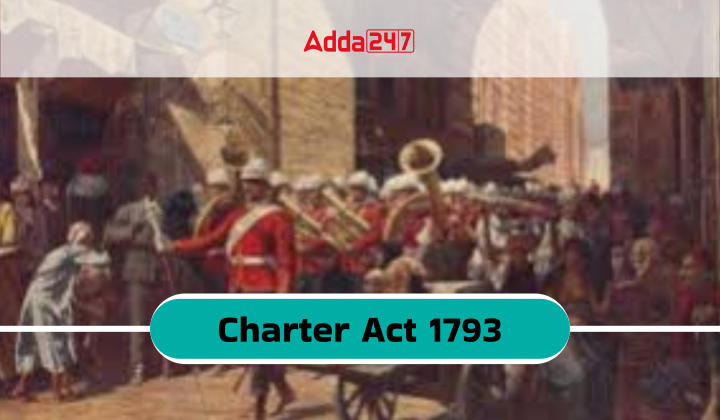Table of Contents
The Charter Act of 1793, also known as the East India Company Act, extended the company’s charter for 20 years, granting it continued monopolistic trade authority in India. Initially granted by the Regulating Act of 1773, this extension ensured the company’s dominance over British territories in India. Despite its importance, it brought about minimal changes to India’s governance or British oversight. This act holds significance in the UPSC Civil Services exam under GS-1.
Charter Act 1793
The Charter Act of 1793 represented the British government’s aim to oversee the operations of the East India Company, which had amassed considerable authority and conversion in the Indian regions over time. Additionally, it expanded the extent of British territories in India, marking the initial move towards the eventual nationalization of the British East India Company. This act materialized following a prolonged advocacy by the company’s stakeholders for governance reform, aiming to enhance its efficacy. It signified a progressive stride towards the continued reform of the company’s affairs within India.
Provision of Charter Act 1793
The Charter Act of 1793 extended the East India Company’s privileges in India for another 20 years and expanded British territories in India. Provisions of the Charter Act 1793:
- Stated that the company’s functions were on behalf of the British government, establishing government control over Indian territories.
- Required the East India Company to pay the British government five lakh pounds annually from Indian revenue, after essential expenses, dividends, salaries, etc.
- Mandated royal approval for the appointment of the Governor General, governors, and commander-in-chief.
- Granted individuals and Company personnel permission to trade in India under the Company’s license, creating a monopoly known as ‘country trade’ or ‘privilege,’ which included opium shipments to China.
- Enhanced the Governor General’s powers, allowing him to override council decisions under specific circumstances and giving him superior authority over governors of Madras and Bombay.
- Allowed the Governor General to appoint a Vice President from civilian council members in his absence from Bengal.
- Separated revenue administration from judicial functions, abolishing revenue courts known as Maal Adalats.
- Stipulated that members of the Home Government would be paid from Indian revenue until 1919.
- Changed the composition of the Board of Control, now consisting of a President and two junior members who need not be Privy Council members.
- Charged the salaries of staff and the Board of Control to the company.
- Banned senior company officials from leaving India without prior permission, considering it as resignation if they did so.
Importance of Charter Act 1793
The Charter Act 1793 played a crucial role in bringing about governance uniformity in India, which was previously fragmented due to diversity and regional kingdoms, reshaping administration under British control. Here are the key changes it brought:
- Enhanced Judiciary: The act made the judiciary more efficient by reducing its workload through the abolition of the Maal Adalats.
- Accountability of Company Officials: Company officials became accountable to the British government, requiring royal approval for their appointments.
- Centralized Administration: Under the leadership of the Governor General, the administration became centralized and more efficient.
- Extended Trade Rights: Trade rights were prolonged for another 20 years for the East India Company, boosting private profit motives and empire revenue.
- Sovereignty Clarification: The act affirmed the supremacy of the British crown, settling the contentious role of the East India Company in India.
- Controlled Executive Movement: Top Company executives could only leave the country with prior permission, enhancing administrative quality.
- Provision for Indian Participation: The act included provisions for Indians to join the civil service, at least theoretically.
- Consolidation of British Power: Elevating the Governor General of Bengal to the Governor General of India strengthened British authority.
- Separation of Legislative and Executive Duties: The legislation separated the legislative and executive functions of the Governor General for the first time in the Board of Council.
Feature of Charter Act 1793
The features of the Charter Act 1793 are provided below. Check the following features:
- Judiciary: The Charter Act of 1793 separated revenue administration from judicial duties, helping the judiciary work better with less stress and more staff.
- Sovereignty: It made it clear that the British crown had more power than the East India Company in Indian territories, reducing the freedom of Company officials.
- Royal Approval: Important officials like the Governor General, governors, and Commander-in-Chief had to be appointed by royal decree, making administrative affairs more transparent and accountable.
- Trade: The East India Company got trade rights for another 20 years, allowing individuals and company personnel to trade in India under the Company’s license.
- Centralization: The Governor General’s authority increased, letting him overrule laws from regional governors and his council under certain conditions.
- Opium Trade: The act ensured the East India Company could trade opium with China.
- Exchequer: Members of the Home Government were paid from Indian revenue until 1919, putting a strain on the exchequer until the practice stopped.
Impact of Charter Act 1793
The Charter Act of 1793 brought significant drawbacks, especially for the Indian population, who suffered further under British rule. Here’s how it impacted:
- Financial Burden on India: Members of the Board of Control were now paid from Indian revenues, adding to the economic strain on India rather than the British Exchequer.
- Extended Trading Privileges: The act prolonged the Company’s trading privileges for another twenty years, fostering monopolistic practices and exploiting the Indian market.
- Centralization Focus: The act favoured the Governor General over other presidencies, undermining the principle of decentralization.
- Transfer of Sovereignty: Sovereignty was shifted to the British parliament, consolidating India’s status as a colonial nation.



 TSPSC Group 1 Question Paper 2024, Downl...
TSPSC Group 1 Question Paper 2024, Downl...
 TSPSC Group 1 Answer key 2024 Out, Downl...
TSPSC Group 1 Answer key 2024 Out, Downl...
 UPSC Prelims 2024 Question Paper, Downlo...
UPSC Prelims 2024 Question Paper, Downlo...




